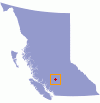Gold Bridge's legacy that encompasses a ‘rich history’ includes the communities of Gun Creek, Gun Lake, Bralorne, Tyax Lake and Marshall Lake. Remarked on throughout history books and tales of the “Gold Rush”, this area was full of mines carved out in search of gold and gold quartz. Passing through Gold Bridge a railway was built leading through the valley to carry passengers and ore. Even though the mines are closed, the stories of haunted houses will entertain you with the references to a few local sightings. Yet nothing is richer than the golden sunrises and picturesque back drops. Traveling by road you can view the watery pass winding among the cliff sides. Today, Gold Bridge is the commercial centre to the Bridge River Valley with accommodations, stops for food, general supplies and gasoline to keep you going. If you do stay a while you can take in some trails and lakes to view wildlife and if you are lucky you may find eagles, owls, swans, plenty of fish, bears and deer.
The rustic wilderness is breathtaking!Population: 250
Highlights:
Bendor Range a favorite spot for alpinists and outdoor exhibitionists
The Gun Lakes are fishing hot spots
Horseshoe Canyon
Rock Hounding
Outdoor Lake Ice Skating (winter)
Things To Bring:
Be prepared: Due to popular hunting areas, visitors should consult the game or forestry offices in Pemberton or Lillooet before venturing into the forests or hire hunting guides.
History:
Miners and their families made Gold Bridge their home around 1859 when gold was first discovered along Bridge River. The largest gold claim in Canada, close to 145 million, was discovered in the Bralorne-Pioneer mine that is situated close to Gold Bridge.
Climate:
Summer average 20 degrees Celsius (semi-arid subalpine pine-forest environment)
Winter (fairly dry) average -2 degrees Celsius (plenty of snow)
Gold Bridge Accommodations
Gold Bridge Things to Do

